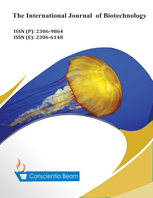Effects of Sodium Azide on the Survival, Growth and Yield Performance of Rice (Oryza Sativa, Faro-57 Variety) in A Hydrocarbon-Polluted Soil
Abstract
The present study investigated the effects of sodium azide on the survival, growth and yield performance of rice (Oryza sativa, FARO 57 variety) in a hydrocarbon-polluted soil. Top soil (0 - 10cm) of known physiochemical parameters was collected randomly from a marked plot beside the Botanic Garden, University of Benin. Thereafter, 10 kg of sun-dried soil each was placed into large perforated buckets with 8 perforations made, at the bottom of each bucket, with a 2-mm diameter nail. Waste petrol-engine oil (WEO) was poured into the measured soil, and thoroughly mixed to obtain 2.5 % w/w oil in soil. Soils were then allowed to attenuate for two months. Rice seeds were pre-treated with various concentrations of sodium azide (NaN3) solution on weight per volume basis (0.004, 0.008, 0.016, 0.032 and 0.064% w/v NaN3 solution) for 6 hours before sowing in polluted and control soils. The untreated seeds were presoaked in distilled water. Results showed that tillering of rice plant was greatly enhanced by NaN3 treatment. At 89 days after sowing (DAS), the average number of tillers observed was 6.70, 7.00 and 7.00 for the untreated plants in unpolluted soil, 0.004%w/v NaN3 and 0.016%w/v NaN3 treated plants respectively. Total number of grains obtained per rice stand was 81 in the untreated plants (control). This reduced to 64 grains/stand in the untreated rice plants sown in polluted soils. However, yield increased to a range of 103 – 159 grains/stand as levels of NaN3 pre-treatments increased. Evidently, pre-treatment of rice seeds prior to sowing in polluted soils enhanced their vegetative growth and yield as well as plant survival.

